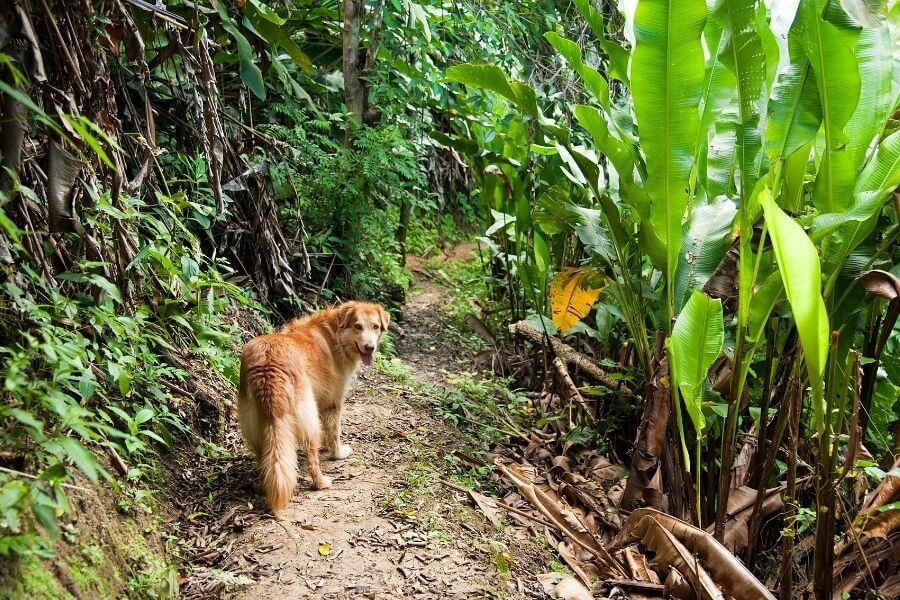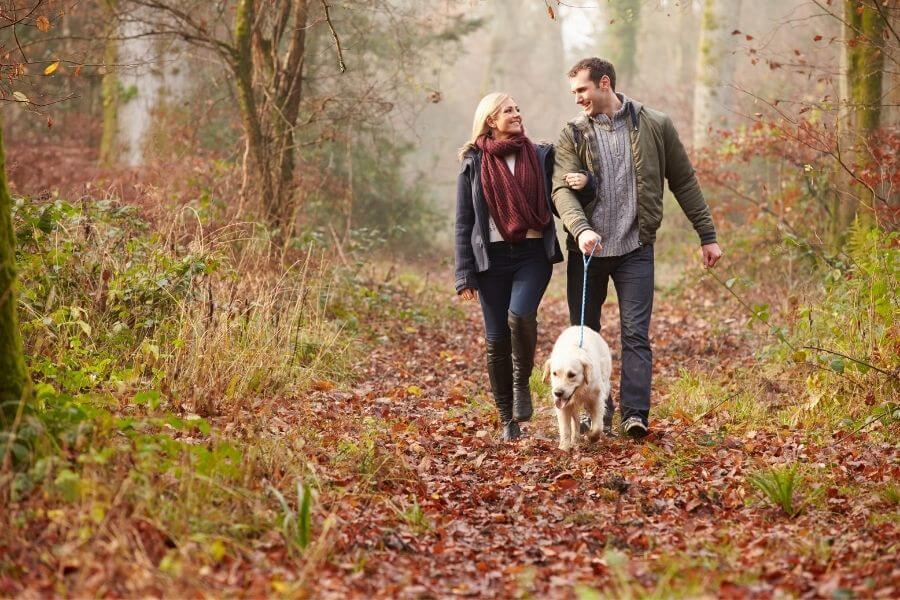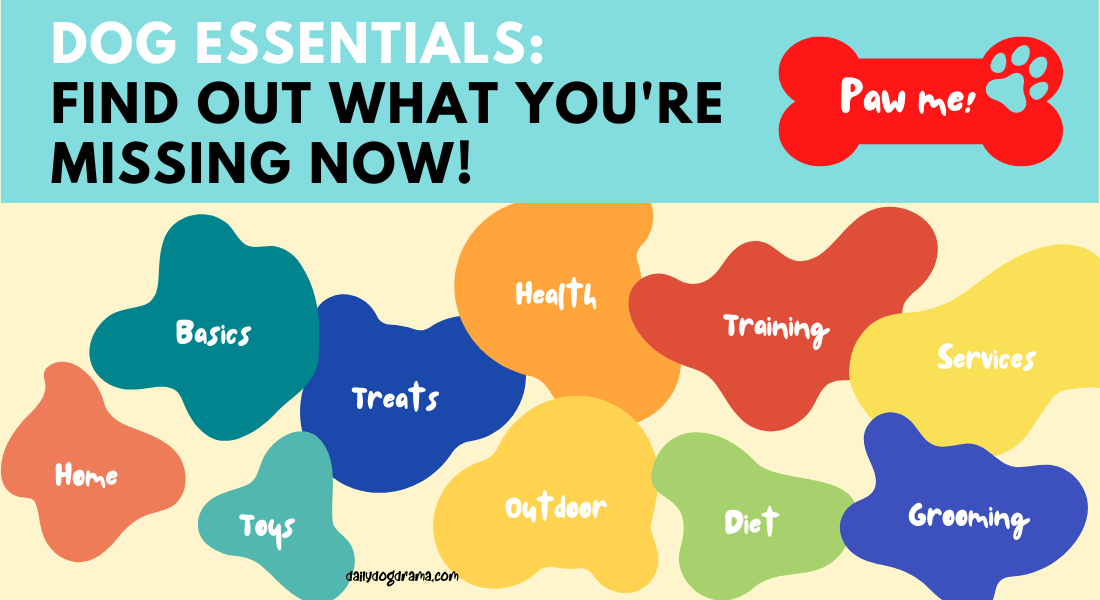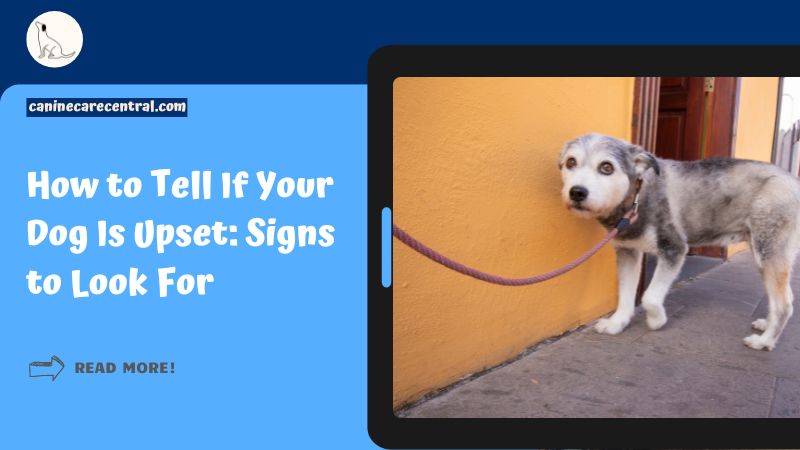Do you know what DOG ESSENTIALS you are missing out? Find out now!
Zack Keithy, our author, is a certified veterinarian technician (UC Blue Ash) for over 6 years (contact him here). The articles written here are based on his expertise and experience, combined with a review by our expert vet reviewers including Dr M. Tarantino. Learn more about us here.
I’m sure many dog owners have experienced this before – taking their dogs out for a nice walk in the woods and it starts running around exploring.
While we want them to fully enjoy the outdoors without a leash, we oftentimes feel worried about them running off and not returning.
What will happen if it got lost? How long can a dog survive in the woods until they are found?
Most dogs will be able to survive in the woods for a very long period of time, likely indefinitely.
They have a natural instinct to forage for food and water even if they are domesticated.
That said, it also depends on other factors such as the environment and the dangers it presents.
In this post, we shall explore more about this topic and what you should do if such an unfortunate event happens to you.
Medical Questions? Talk to a Veterinarian 24/7.
Connect one-on-one with a licensed vet who will answer your questions in minutes.
*Article may contain affiliate links to retailers like Amazon and Chewy. Learn more on our disclosure page.
- How many days can a dog survive in the woods?
- What Helps a Dog Survive in the Wild?
- Experience and Training for Dog Survival
- Threats your dog faces in the woods
- How to find my dog if it’s lost in the woods?
- How to Ensure Your Dog Is Never Lost Again?
- Frequently Asked Questions (FAQs)
- In conclusion: How long can dogs survive in the woods?
How many days can a dog survive in the woods?
To be absolutely honest, we may never know how long a dog can survive in the woods and there are very reasonable points why that could be.
While a healthy dog may survive many days without food, an ailing dog may not make it past a day or two.
If your dog is lucky to have a water source nearby, it could probably survive more days without the risk of being dehydrated.
Although your dog may live without water for up to 72 hours, the truth is, its survival rate may become vastly reduced after the first 24 hours as delirium creeps in.
Beyond the initial 72 hours, any damage to your dog may be permanent.
If the water is contaminated with bacteria or viruses, it could cause your dog its life sooner than expected too.
Your dog’s survival length in the wild is also highly dependent on if there are other predators like coyotes nearby, if it has shelter from the rain and heat in the wild, or if it is smart enough to escape any traps set by hunters for the wild animals.
In any case, the matter is very much dependent on your dog’s physical condition and the surroundings it is in.
If your dog is lucky, it could survive beyond days…even weeks!
Doggy says, read this too: Why does my dog scratch my bedsheets?
What Helps a Dog Survive in the Wild?
As dogs are descendants of gray wolves (Canis Lupus), your dog’s survival rate in the wild is highly dependent on how fast it can switch to the ‘survival mode’ instinct after being separated from you.
Even though dogs are very much domesticated pets these days, they do still have a side to them that was once wild in ancient times.
Your dog’s survival rate also depends on its breed, size, training, past experiences, and circumstances around him when it was lost.
Some breeds like Huskies, Malamutes, and Akitas could make quick natural adjustments to survive in the wild as they are bred and genetically made to live in harsh outdoor conditions.
Depending on the breed, some dogs do not go into survival mode for weeks and hence may have their survival rates compromised by the unfamiliarity they face in the woods.
Smaller dogs may also have a lesser survival rate as they become easy prey to other wild animals such as wolves or coyotes.
In other words, a great, fresh, and newly available food source.
If you have experience bringing your dog out into the woods to camp or hike, it may be able to survive based on the unconscious training you equipped it with in the past.
Some dogs with higher natural survival skills may have heightened senses as they know they are in danger and therefore will never heed a command from a stranger, or be lured by a squeaky toy.
Then again, to truly survive in the wild for long, your dog will need a pack to hunt together as predators like other wild dogs, wolves, or coyotes may get in the way of their food source.
Not being able to hunt in a pack means your dog will be left without a food source.
Doggy says, read this too: Do dogs smell before they die?
Experience and Training for Dog Survival

Your dog’s survival in the wild is dependent on its trainability, size, body type, temperament, obedience level, sports level, agility, adaptability to changes, and overall breed health.
While some dogs regardless of their size can be trained to track and trail, some breeds can be trained further to hunt, sport, guard, or even herd.
Its ability to pick up skills quickly and its adaptability to changes may help your dog to survive the wild longer.
As a general rule of thumb, all dog breeds should be trained in basic obedience commands from young.
This way, it helps your dog to listen to commands like ‘Stay!”, “No!” and “Come!” quickly if it ever makes a daring dash off into the woods.
Some breeds like the Akitas, Huskies, and Malamutes are naturals in handling stressful and intense situations.
They are able to go into survival mode quickly to adapt to the situation and hence may be trained in more adept ways to survive the wild.
They may also be able to run faster and longer when faced with a threat.
In the case where your dog is to survive by itself in the woods, size and body type do matter too.
Larger dogs are better at defending themselves against predators compared to smaller breeds.
Some dogs which have had prior exposure to spending time in the woods be it for training purposes or just for hikes or to camp with their owners may also be able to withstand the harsh wild conditions and survive longer on their own.
They may also be in better shape mentally and physically as compared to city pets.
If you have brought your dog to a particular area of the woods before, it may be able to find its way back to the campsite or hiking trail based on the familiar scents as exposure breeds familiarity.
It may also be able to seek familiar shelter too.
For your dog’s survival instincts to kick in quickly in a situation like this, you will need to accustom it to areas and scopes beyond the confines of your house or nearby city parks.
Real-time outdoor time spent with your dog will guide them to identify and get used to the sights, sounds, and other scents that may be helpful to them if they ever get lost in the woods.
Doggy says, read this too: How far can dogs see?
Threats your dog faces in the woods
Although your dog may have better survival skills than others in the woods, it may still face different threats that could harm it as life in the woods is never predictable.
For one, if your dog is unable to find a food or water source within the next 24-72 hours after getting lost in the woods, it may become delirious and that would cause impairment in its sight and vision to further search for food and water source.
Contaminated food and water could also be another big threat to your dog even if it managed to find a source as diarrhea and vomiting kick in.
The inability to find shelter from the rain, overwhelming heat, and the presence of predators is also another major threat to your dog as scavenging coyotes or wolves in packs may decide to hunt down your dog as a food source.
Likewise, if your dog is hurt or has fallen sick while trying to survive the wild, it may become confused and delay the healing process of its wound.
Any unhealed wound is a comfortable bed for bacteria, viruses, and even maggots to find a home in.
Eventually, your dog may succumb to the impending situation.
Depending on the terrain where your dog is lost, dangerous animals and insects, poisonous plants or fruits, traps set by hunters, loose rocks, and uneven cliffs may be dangerous to your dog as well.
Doggy says, read this too: Do bully sticks make dogs aggressive?
How to find my dog if it’s lost in the woods?
To find your dog in the woods, you must act quickly as time is of the essence.
You may first want to let everyone in your neighborhood, work, or park area know of your missing dog and request for them to report any sightings to you immediately.
One good way of disseminating important information about your dog i.e. his latest photo, name, color, breed, and size would be to post on social media.
Beyond that, you may want to print posters in color to be put up in all the areas your dog frequents.
Upon any sighting reports, you may begin the work of leaving a piece of clothing with your scent near areas of the woods towards the exit path.
You should leave only clothing that has been worn longest, and not washed for a better chance of your dog finding its way back.
You may also consider leaving its crate near where your dog was last seen in the woods.
Leave some water and his favorite food nearby as well to ensure that your dog can be comfortable if found.
Therefore you must check back on the spot every day as it may be waiting for you in its crate!
You should also consider getting help from the local shelter or animal rescue organization to set up harm-free traps to try to capture your lost dog in the woods.
It would be wise to consider setting up a trap in one spot for a few days before changing locations for a better chance of finding your dog.
Doggy says, read this too: Can Chihuahuas Live Or Sleep Outside? Know The Dangers

How to Ensure Your Dog Is Never Lost Again?
There are a number of ways to really reduce the chances of your dog going missing, whether you are out in the woods or even just a stroll in your neighborhood.
Here are my top tips for making sure your dog does not get lost:
- Get your dog fitted with a high-quality collar that contains all the relevant contact information such as your phone number. You may also wish to include your address, although some might find it too private.
- Bring them out regularly and get them familiar with the place before letting them run around freely without a leash.
- Get them trained to listen to your commands so that they will not wander off.
- Ensure they are microchipped and that they have a GPS tracker. I highly recommend the Tractive GPS Dog Tracker.
Key Benefits
- LIVE TRACKING & LOCATION HISTORY – Pinpoint the real-time location of your furry friend when it matters most and see the history of places your dog has visited.
- ACTIVITY MONITORING: Keep your dog healthy with the integrated dog fitness tracker
Doggy says, consider reading this too: Are Vizslas Good Guard Dogs? Suitability for Your Family
Frequently Asked Questions (FAQs)
How far can a dog run in a day?
Most dogs can run between 2 to 5 miles in a day, depending on their breed, size, and health condition. You should never push your dog to run too much from the onset, but rather increase the distance gradually. Always have water readily available for them and look out for signs of them slowing down or heavy panting.
When to stop looking for a lost dog?
As a general rule, you should immediately search for your dog the moment you realize it has gone missing as the first 24 hours are crucial. The chances of recovering your dog go down between 5% -65% after the first 24 hours. While there are also statistics to show more successful findings of lost dogs within the first 30 days, there have been cases where dogs were returned to their owners months or even years after. Therefore, you may choose to look for your dog as long as you want although the chance of recovery may become slimmer as the months pass.
In conclusion: How long can dogs survive in the woods?
If you find yourself in a situation where your dog has run into the woods and not returned, the key thing is not to panic.
Immediately inform any other hikers who are entering the woods to keep a lookout for them and check with returning hikers if they have seen your dog.
The other tips above will help you in your search and you must take all actions quickly.
I personally think that you should keep your dog on a leash at all times in order to prevent such a scenario from ever happening, and also for the safety and comfort of other people around.
You can still have lots of good fun with your dog this way!
Browse around for other articles about dog behaviors such as how long is a day for a dog, why is my dog dragging another dog’s collar, why do dogs sleep with their bum facing you, and many more!
You’ve made it to the end, but I hope it’s not the end of our journey. We want to hear your voice! Share your thoughts, problems, suggestions, or anything related to your dog in the comments section. And don’t forget to join our newsletter today too.





